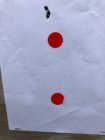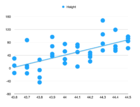This type of method is junk. Try it a few more times and you'll see different "flat spots" or none a tall. It's just random variation. Show me a test where the flat spot is significant statistically, and I'll eat my hat. Charge weight vs velocity is linear for our purposes.
There is only so much information contained in one shot. If you're smart about it you can develop a load efficiently, but you still need to shoot.
I believe these methods come about because people are misunderstanding ladder tests, which are legitimate. Plotting velocity vs vertical impact will show you something if you do it over wide enough of a charge range. But that's got nothing to do with velocity flat spots. It's *vertical* flat spots we're looking for. Even then, it's easy to look at the data and see something that's not there.
A real example of how we lie to ourselves. For kicks, I thought I'd do a ladder within a very tight charge range. A one grain range in .1 grain increments. All charges were weighed with an FX-120i, and shot through my F Class rifle at 600 yards. Bullets were my customs, and sorted. Cases were sorted by weight. Velocity was measured with a Labradar. Impact height was measured by a ShotMarker. I did 4 separate tests and wind was not much of a factor, as it was pretty calm. Seating depth was at a known good spot from a previous load. Velocity variation for a single load yielded SDs between 3 and 10, although with only 4 shots each, so lots of variation would be expected. If I had to eyeball a guess as to the overall SD I'd say it was about 6. I didn't bother figuring that out.
So lets look at the charge weight vs impact height. Looks like a step-like shape and that there are three nodes, right? Pretty cool. That's what a ladder is supposed to look like.
View attachment 1182860
Now lets plot that same data as velocity vs impact height. Still see a step pattern? I don't. Turns out that using charge weight as a proxy for velocity happened to show me something that looks like what I expected to see, but was in fact a mirage. There is no meaningful "node" within the charge range that I tested. I suspect I'd see one if I kept going lower, but that in itself is dangerous. Let the numbers talk - don't tell them what to say.
View attachment 1182861
Be careful - preconcieved ideas about what you should see can be deceiving when you don't have much data.



















